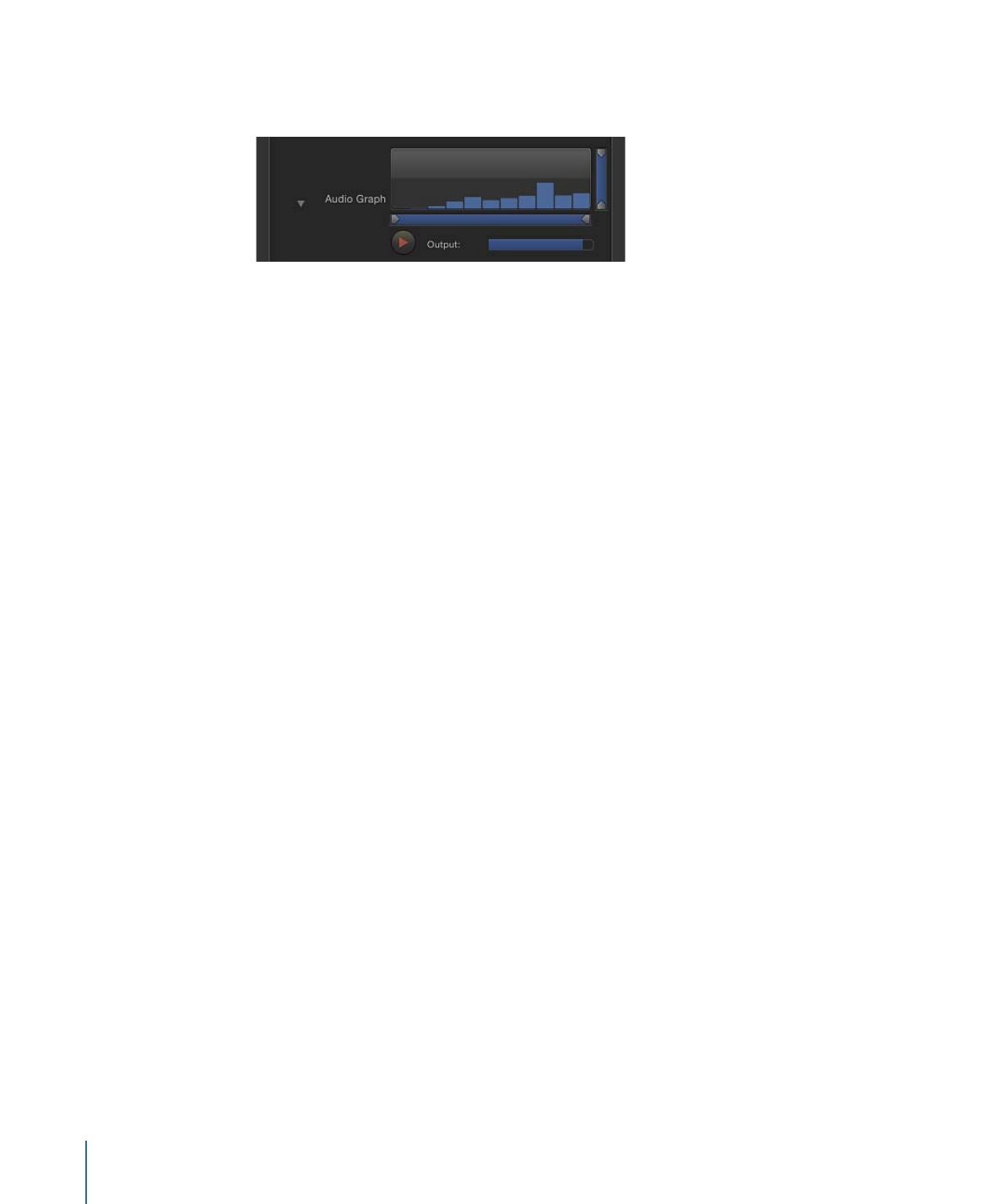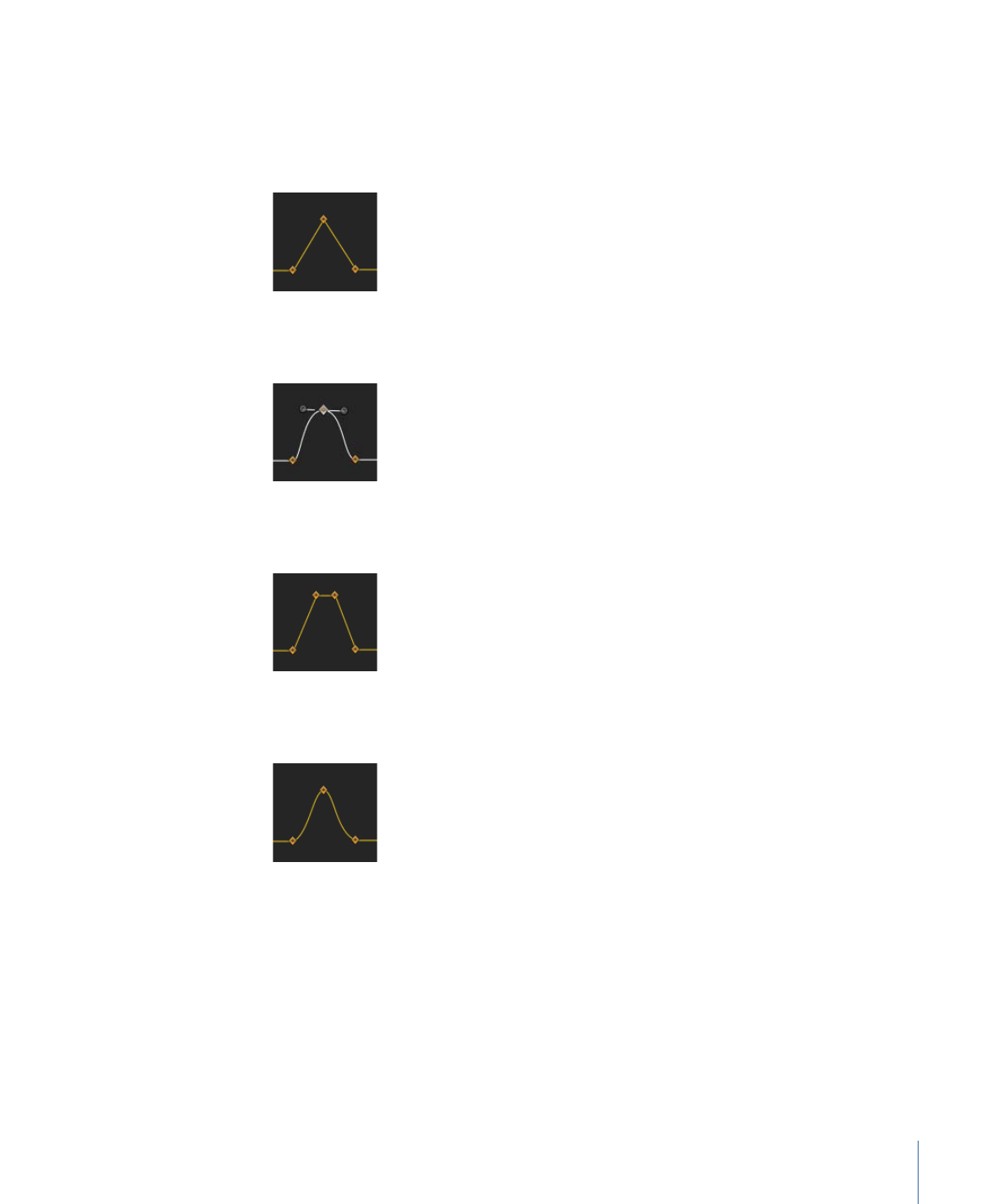
Audio
The Audio parameter behavior performs an analysis of a specific property of an audio
track, then applies an animation curve to a parameter based on that analysis.
Parameters in the Inspector
Source Audio:
Sets the audio track from which to read audio data. Can be set to any
single audio track in the project, or the Master track. Drag an audio clip or a video clip
with audio into the Source Audio well, or use the pop-up menu to choose a source for
audio analysis.
Note: For the Audio parameter behavior to have an effect on an object, audio must be
present in the Audio Timeline at the position of the behavior.
Respond To:
A pop-up menu that sets the type of audio data analysis to perform. Choose
Amplitude or Transients. If set to Amplitude, the behavior responds to peak values of a
particular frequency. If set to Transients, the behavior responds to rapid changes in
frequency.
Graph Range:
A pop-up menu that sets the initial range of frequency values to be analyzed
by the behavior. There are four options: All Frequencies, Bass, Mid, or Treble. The choice
of display affects the frequency range of the Low Frequency and High Frequency
parameters below.
1383
Chapter 23
Working with Audio

Audio Graph:
A graph displaying a visual representation of the Source Audio data analyzed
by the behavior per frame.
During playback initiated by the Play button beneath the Audio Graph, the selected
Source Audio data appears. If audio analysis is being performed, a progress bar appears
in the Audio Graph area.
The values of Low Frequency, High Frequency, Floor, and Ceiling can be set by dragging
the small triangles along the bottom or right side of the graph. Or they can be set
numerically using the four sliders underneath the graph to isolate specific frequencies
and values for analysis.
Low Frequency:
Sets the low frequency threshold of audio analysis. Only audio frequencies
above this value are analyzed. Values range from 1 Hz to 22,050 Hz.
High Frequency:
Sets the high frequency threshold of audio analysis. Only audio
frequencies below this value are analyzed. Values range from 1 Hz to 22,050 Hz.
Floor:
Sets the minimum value of audio input, below which results are ignored. Values
range from 0 to 1.
Ceiling:
Sets the maximum value of audio input, above which results are ignored. Values
range from 0 to 1.
Smoothness:
Sets the window size to smooth the result curve. Any value other than 0
triggers a keyframe reduction with an error tolerance of 1%. Values range from 0 to 10.
This parameter is only available if Respond To is set to Amplitude.
Note: Depending on your audio file, Smoothness values greater than 7 may result in
audio playing out of sync.
Sensitivity:
Sets the sensitivity of the transient detection. Values range from 0% to 100%.
This parameter is only available if Respond To is set to Transients.
Channel:
Sets the audio channel to analyze. Value can be set to Mix/Mono, Left, or Right.
Note: With a multichannel audio file used as a source, Mix/Mono must be selected for
audio analysis to be performed properly.
Peaks:
Sets the way the key points are linked when drawing the peak curves generated
by the audio analysis. Value can be set to Sharp, Smooth, Square, or Continuous.
The different peak types are described in the list below.
1384
Chapter 23
Working with Audio

Note: The examples below are for reference only. Because the audio behavior does not
generate keyframes, you won’t see keyframes in the Keyframe Editor.
• Sharp: Each peak of the animation curve is described by three keyframes with a straight
line drawn between them. A selected keyframe has no tangent handles.
• Smooth: Each peak of the animation curve is drawn by a single keyframe with a Bezier
curve. A selected keyframe has a tangent handle to change the shape of the curve.
• Square: Each peak of the animation curve is drawn by four keyframes. A selected
keyframe has no tangent handles.
• Continuous: The animation curve behaves like Smooth interpolation, but without access
to Bezier handles, because they are calculated automatically from peak to peak.
1385
Chapter 23
Working with Audio

Attack:
The animation curve shows the amount of the offset in frames between the first
keyframe of the curve and the peak of the curve generated by the Audio behavior. The
number of frames that the curve takes to reach its peak from its initial value is called the
Attack. This parameter is only available if Respond To is set to Transients.
Attack side of the curve
Release:
The animation curve shows the amount of the offset in frames between the
peak of the curve generated by the Audio behavior and the last keyframe of the curve.
The number of frames that the curve takes to reach its final value from its peak is called
the Release. This parameter is only available if Respond To is set to Transient.
Apply Mode:
Sets the method by which the audio analysis affects the curve. Value can
be set to Add, Subtract, Multiply, or Add and Subtract.
Delay:
Sets a delay in frames to offset the resulting keyframes.
Scale:
Sets the scale factor to affect the result of the audio analysis.
Apply To:
Sets the object parameter to which the audio behavior is applied.
HUD Controls
The HUD contains the Source Audio, Respond To, Graph Range, Audio Graph, Scale, and
Apply To controls.
1386
Chapter 23
Working with Audio

When you are ready to distribute your project, there are many possible output options,
found in the Share menu. These options generate a file (or files) that contain a rendered
version of your project.
This chapter covers the following:
•
Share Menu
(p. 1387)
•
Render Options for Sharing
(p. 1388)
•
Sharing to Apple Devices
(p. 1389)
•
Sharing to Disc or Creating a Disk Image
(p. 1391)
•
Sharing to Email
(p. 1394)
•
Sharing to Video Sharing Sites
(p. 1395)
•
Exporting QuickTime, Audio, and Image Sequence Media
(p. 1398)
•
Exporting Frames
(p. 1402)
•
Exporting for HTTP Live Streaming
(p. 1402)
•
Exporting Using Compressor
(p. 1403)
•
Background Rendering
(p. 1405)
•
About Share Monitor
(p. 1405)
Share Menu
The Share menu provides various options designed to make it easy to distribute your
project. Most options have a specific target, such as an Apple device connected to iTunes,
a Blu-ray disc, or a specific website.
There are also options for exporting broadcast-quality or highly compressed QuickTime
movies, image sequences, audio, and still images. You can customize the settings of each
method of export to suit your specific needs.
1387